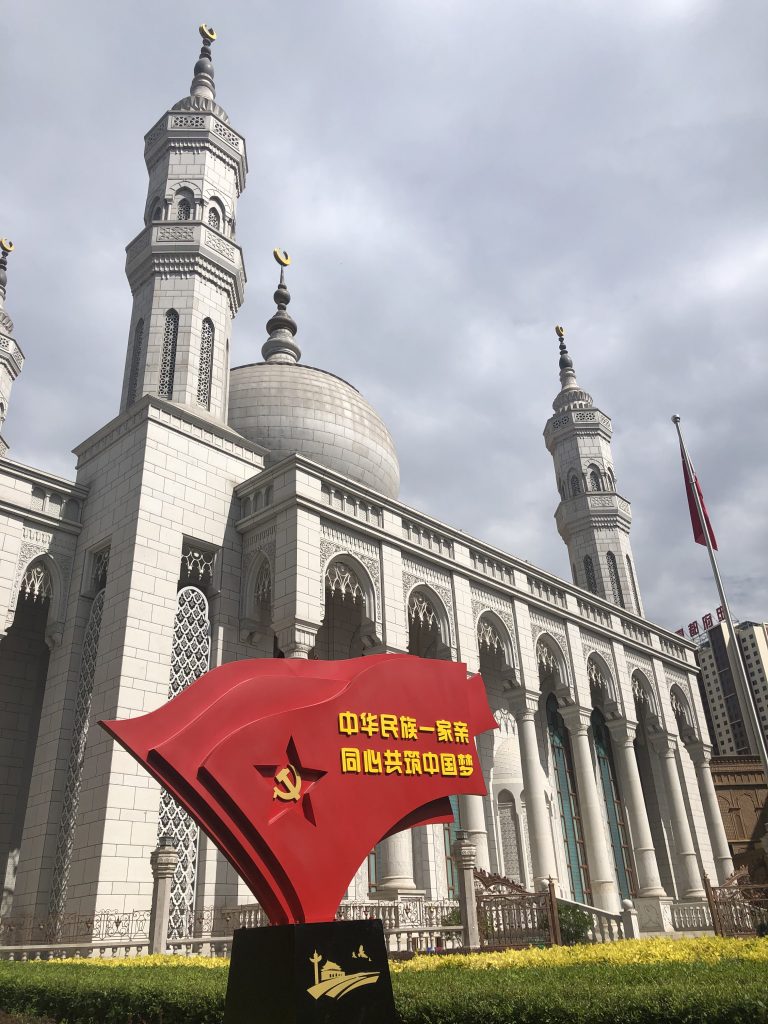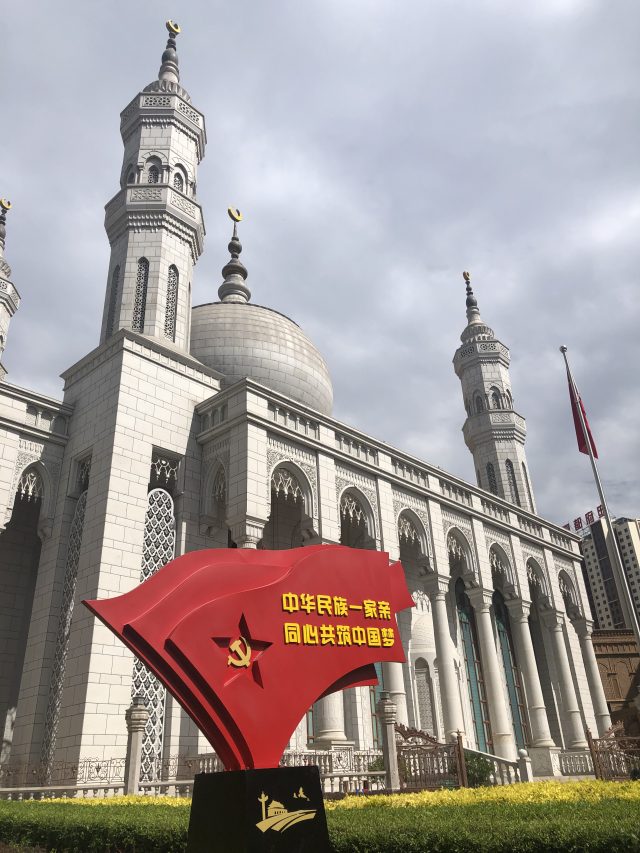This is the third day of my travel for the research. I am currently in Xining, trying to observe and interact with people, objects, and spaces as much as possible. The more I dip into the real world, the more I realize how problematic my initial image and assumptions about the situation is. I have been trying to clarify further to myself of how the conceptualization of the project may be revised so the outcome can be less biased and distorted by personal political references and unsupported bias and imaginations. Because I am still in the middle of the travel, there are still two cities that are waiting for me. Some details of the text below will be added and revised. However, it is what I have been thinking through and I would love to see if my thought process makes sense to you guys. Please let me know what you think of this crude edition of my introduction to the research.
“The project is first inspired by the news about the recent conflict between the Chinese government and the Uyghur community in Xinjiang. In the project proposal, I have expressed doubts about the reductive terms used in labeling diverse populations, especially minority populations in China. I see the government’s employment of the terms, Hui, Uyghur, and other names of any ethnic group as a strategy of separating the minorities from the majority, which also has one even more problematically unified name, Han, for political stability and, more importantly, nationalistic agenda. One of the major ways of identifying these minority groups from their majority counterpart is religion: both Hui and Uyghur are, mostly, Muslim; whereas the Han population are mostly occupied by either a vaguely-defined atheism or a folk belief associated with popular Buddhism and Daoism (which is usually labeled in the mainstream media and politics as superstition and dismissed as either mere “culture and tradition” or unsuitable to the communist society). This general division is, therefore, naturally implied in every usage of these names of ethnicities; the religious identity of many Hui and Uyghur is now also implied as the identity for the entire ethnic group.
However, this generalization is problematic for it leads to two misunderstandings of Hui. The first stems from the unclear meaning of “Hui:” whether its original signifier is an established ethnicity or religion. The identity of Hui, according to Michael Dillon in his book, China’s Muslim Hui Community, unlike the general conception of being born into, was, for the most part, self-assigned to people who were Muslims in China. The origin and the usage of the term are still debated between whether it covers every Muslim in China (including members from other ethnic groups like Uyghur) or a more specific population with shared ancestry and cultural heritage (Dillon 1999). This confusion (with no negative connotation) is still vividly seen during the research. For instance, I met the owner of a women clothing store near the Dongguan Mosque in Xining. During our conversation, she has expressed several times that one does not need to be a Hui to become Muslim. However, when we were talking about how some women in other Muslim countries dress (in Niqab and other fuller coverage style) differently than the majority here in Xining (mostly hijab), she said: “they are better Hui than we are.” To not go into the other interesting implication of her comment on Muslim female fashion, she clearly does not see the two usages of the term Hui as controversial. It can mean both the smaller population in China and the bigger population of all Muslims, in this case even extending outside China. It is during this conversation that I start to doubt whether my initial idea that the association of the Hui community and their religious identity as simply reductive and politically manipulative is completely appropriate. If confusion naturally exists in people’s mind, what is the value to insist to separate the two meanings apart?
The second misunderstanding of the strong association of the Hui identity with Islam is that it leaves out those who identify as Hui and not Muslim. It might also cause confusion for those who are Muslims cannot be identified as Hui on their shenfenzheng, or state-issued ID cards, if Hui means all Chinese Muslims. This misunderstanding is clearly shown in the new reports of the persecution of the Uyghur community, on which the initial conception of the project is based. Many articles, from their headlines, deliver a reductive message that Uyghurs are persecuted by the Chinese government simply or mainly because they are Muslim while china is mostly atheist. Loose terms, such as “Uyghur Muslims[1],” “Muslim ethnic minorities[2],” are used closely linked and even interchangeably with “Uyghur” and “Muslim” as if they all refer to the same group of people. Perhaps no one really knows which precise group of people the government is after, these word choices, however, also imply some political intentions of the news agencies. However shocked and angry I was upon hearing the news, I also had doubt about this manner of deliverance and the causal or correlational relationship between their religious identity and the government’s policies the articles provided. Despite the Muslim identity is generally associated with the Uyghur community, the reduction shown in the articles, I argue, still have a strong western perspective in service for the trending discourses over the Muslim community in the United States and Europe nowadays. From there I started to wonder why an association can be interpreted, innocently or purposefully, as a causal relationship and no matter whether this causal relationship is grounded in reality or not.
It seems easy to rebuke the reduction delivered by the media and the government and to conform to a fashion to question and deny these generalized statements and correlation between the religious identity and a static population. However, the interactions I have had with real people from Xining, Lanzhou, and Yinchuan, however, suggest a more complicated situation. The relationships people have with their identities as both Hui and Muslim demonstrated to me in the real world, seem to trouble both narratives that claim a strong causal relationship and no correlation between the two identities and their impact on people’s life and self-conception. For instance, I have encountered many Hui people (the use here purely means that their government-issued ID cards identify them as Hui) who may still observe some dietary restrictions associated with the ethnic group yet who claim no affiliation to Islam. Though I have conducted no formal statistical investigation, these secular Hui, however, appear not to be small in number. When I asked the Muslim Huis who I met during the research about these secular people supposedly within their community, they seemed to not be able to identify with them; some were even critical, saying if they did not worship, they were not good Hui, or even not Hui at all. However, when I asked about stories of people who converted to Islam outside the Hui ethnicity, such as Han, Tibetan, etc, they seemed to be more excited and praised to me about how pious, faithful, and “good Hui” their converted friends were. Do their reactions suggest that they think the religious identity is important to the ethnicity Hui? Will their counterparts, in this case, the secular Huis, agree? Is this question mainly influenced by whether the person identifies more with their ethnic or religious identities? These are all questions unanswerable in the scale of this project; however, they are important to lay out before the project to remind both me and the reader the complicated nature of this topic. It is crucial, therefore, to remain cautious and critical towards every usage of these terms: Hui, Muslim, Hui Muslim, etc; and to keep asking, what do they mean, who do they signify, and whether such questions are biased in nature.
Therefore, three days into the research, I have decided to shift my attention of the research away from how people and the government confuse over ethnic and religious identities because the question itself suggests a biased situation further away from reality than I had imagined. I would like to revise my topic to simply observe the spaces where religious and social activities occur. The observation of how the spaces are used by people within and outside the community[3] and the spontaneous interactions with the local people, perhaps, may unveil some aspects of how people actually conceptualize their identities as both Muslim and Hui, how people outside the community imagine the merge and the separation of the two identities, and how these conceptions may shape their social, religious, and even political lives in this society. In other words, the research wishes to get in contact with the real world in order to not only undo the misunderstandings discussed above but also to not ignore the inherently controversial reality only for the sake of theoretical cleanliness or political correctness.
This paper will be presented in chronological order of my visit to three cities, Xining, Lanzhou, and Yinchuan. These three cities are the capitals of three provinces located on the borderline of a majorly Han occupied central China and provinces with a more diverse population usually situated in the west. These three cities are also known to have significant mosques that center the local Muslim, or in these cities Hui, communities. However, these cities are also distinct for they are situated in three different provinces home to three different demographics (the detail of which will be provided in the following sections) which show the subject of the research in three contexts: in a diverse province with another influential ethnic group other than Han (Xining), in a more homogenous Han province (Lanzhou), and in a more homogenous Hui province (Yinchuan). Thought he demographics may convey some information about the life of the Hui community in these cities on an abstract and theoretical level; however, how and how much these contexts are shaping the significance of the mosques, the living spaces of the Hui and/or Muslim demands no quick answer. The selection of the three sites is only an effort to provide a somewhat complete image, though it has to be noted that Hui and other gatherings of Hui are scattered all over China, making any generalized statement problematic and inherently politically biased. Each big section for the three cities will be crudely divided into two focuses, a survey of the mosques where public religious activities for the Muslims occur and a survey of the city where social activities within the Hui and between the Hui and other groups take place. This organization suggests that this project will not be able to conclude in any general terms about the life of Muslims in China, for the research is location-specific; however, the study, hopeful, may add some data to the larger studies and some original perspectives in approaching the subject and interpreting the spaces and the language that are both used by them and by which they are also shaped. “
[1] https://www.abc.net.au/news/2019-07-19/pompeo-calls-china-uyghur-treatment-stain-of-the-century/11323946
[2] https://eurasiantimes.com/china-thanks-uae-for-supporting-crackdown-on-uyghur-muslims-in-xinjiang-province/
[3] I would like to convey my concern over this term.

For academic and theoretical support, I am currently relying on Graham Harvey’s book, Food, Sex, and Strangers. I am very excited by his idea of “real world” and “going/ looking elsewhere” I will be doing more theoretical research after the onsite research, please let me know if you have good texts about space, ethnicity, indigeneity, and popular religion!
[1] I would like to convey my concern over this term.
